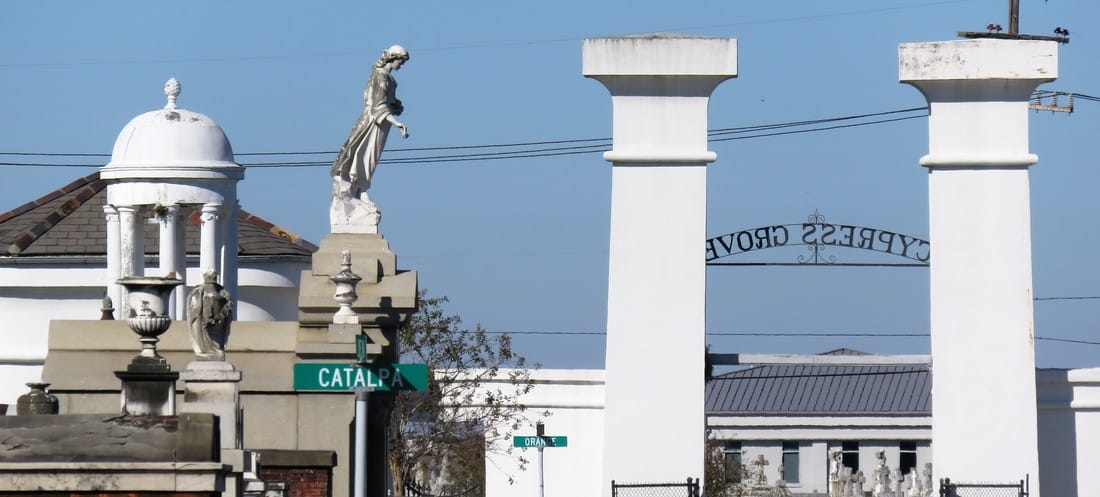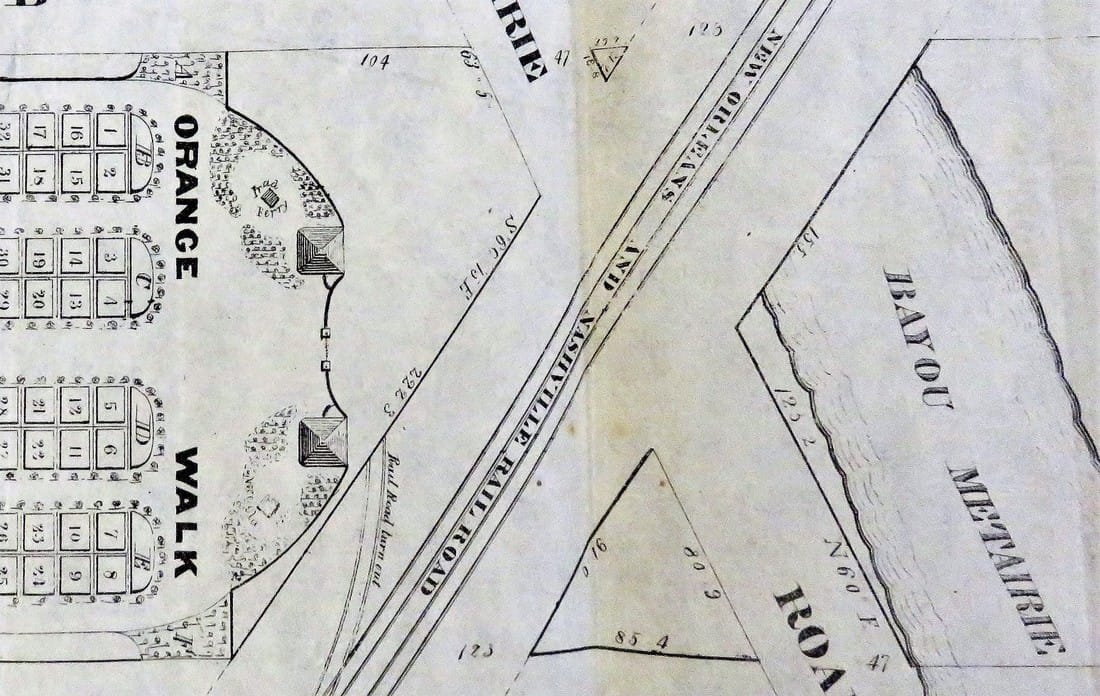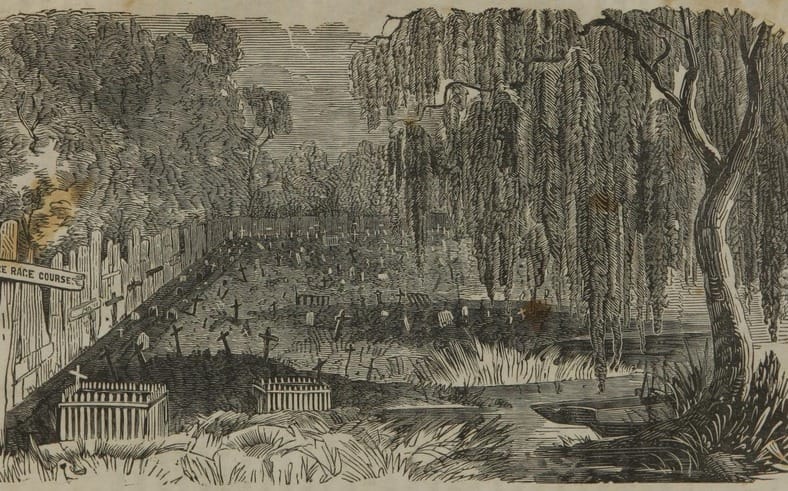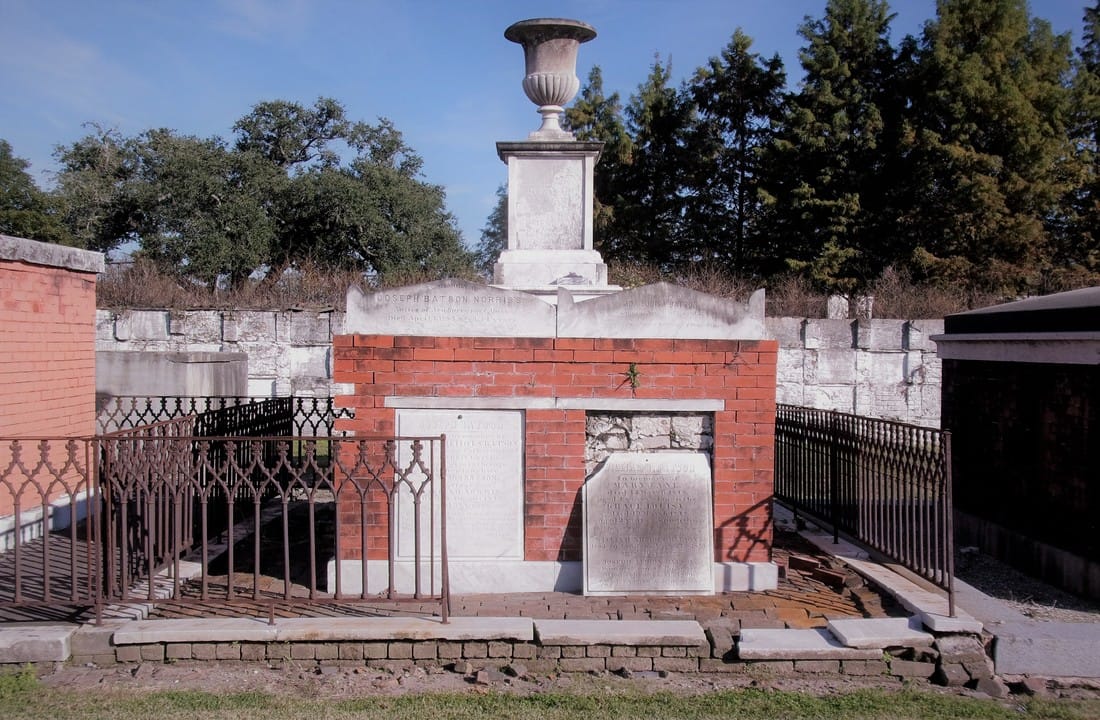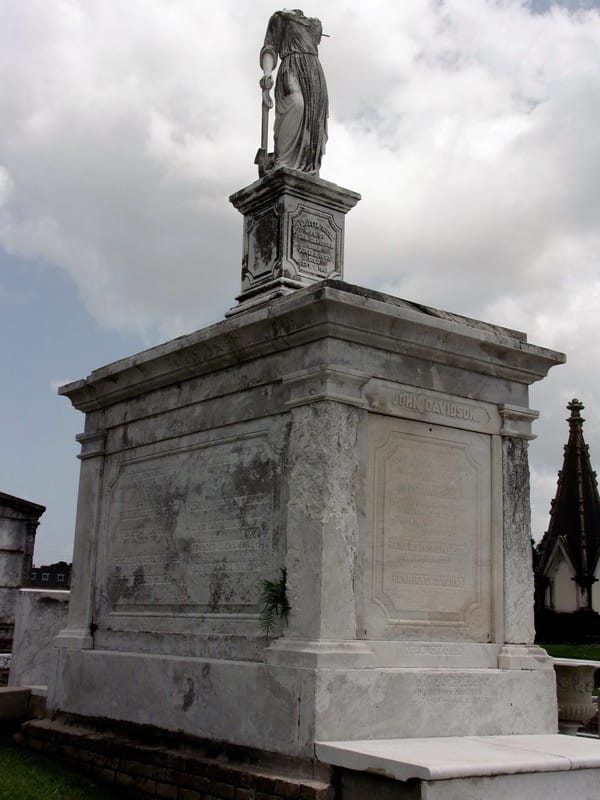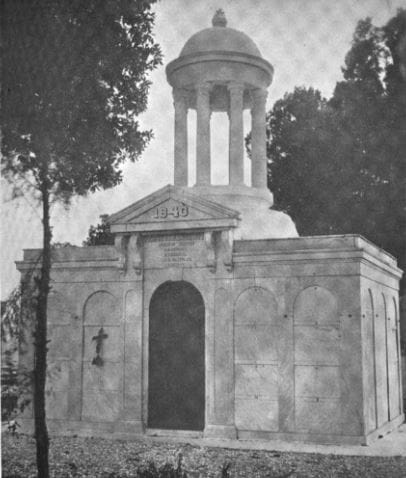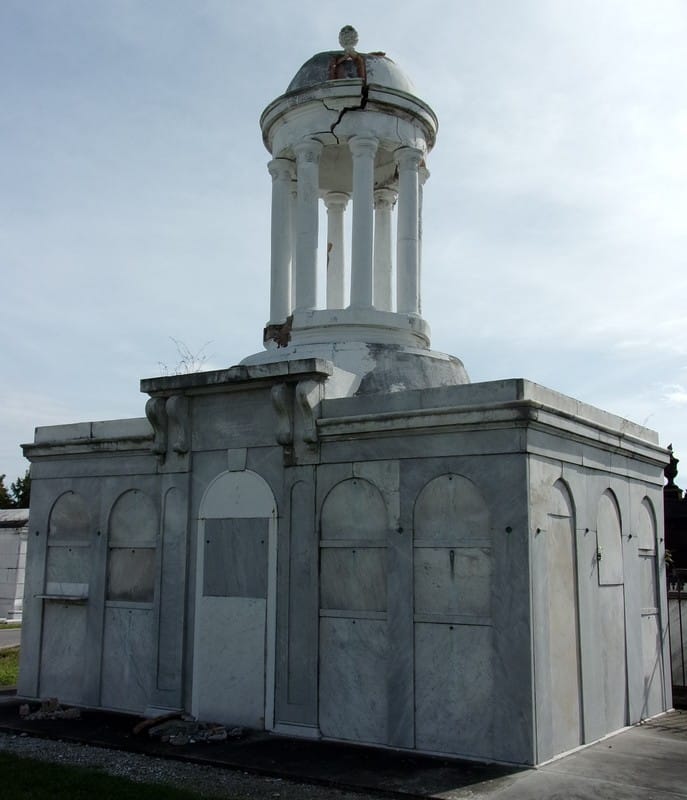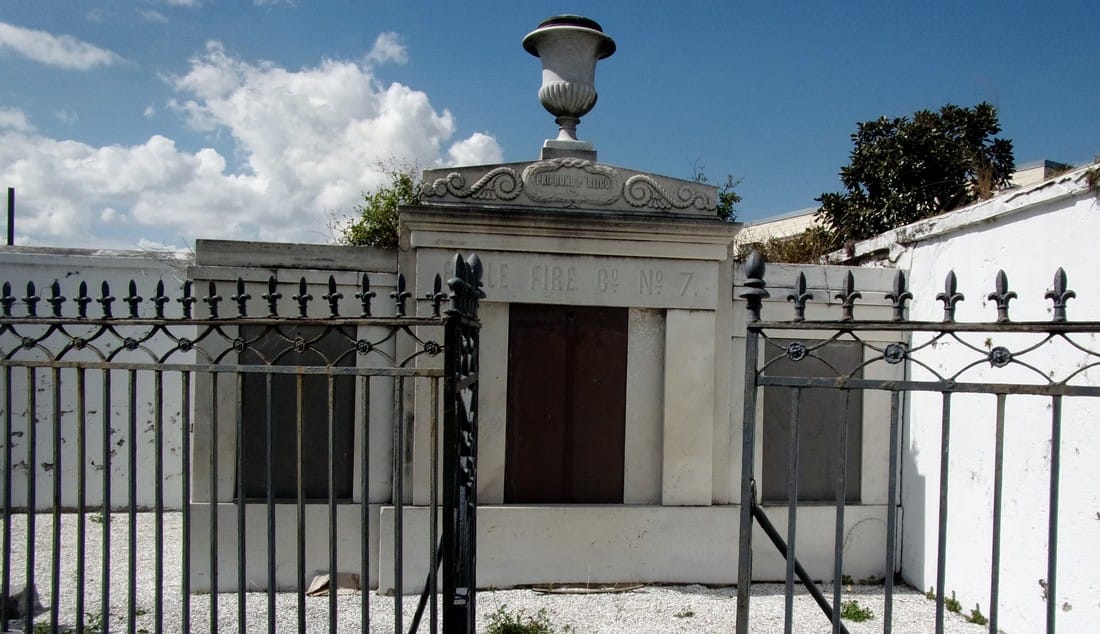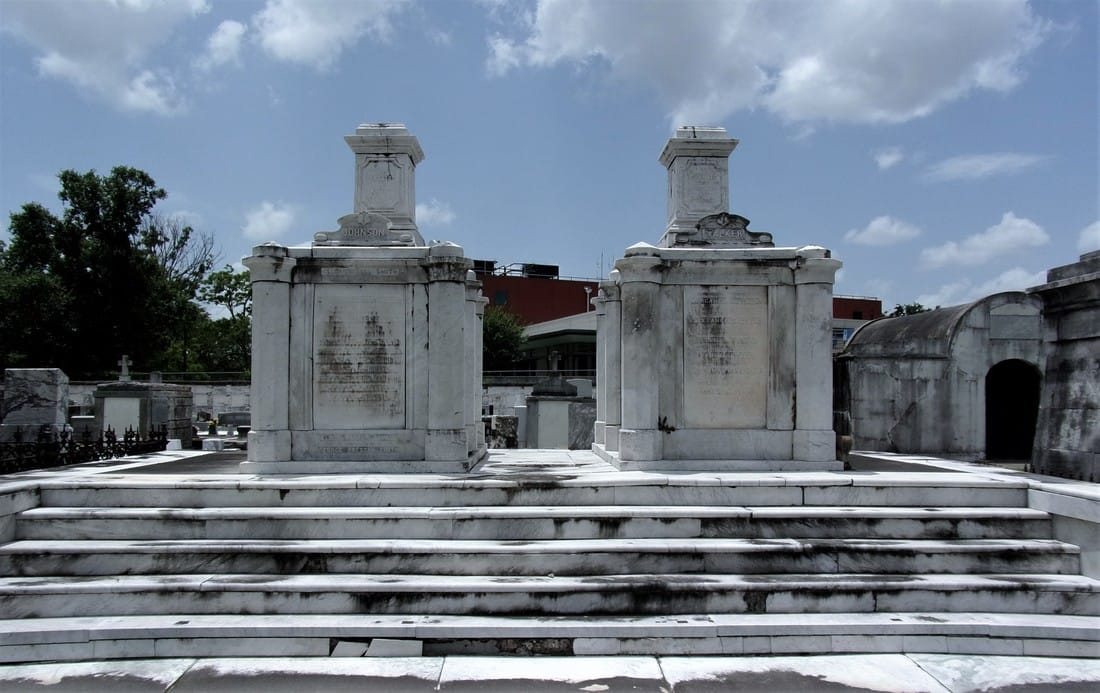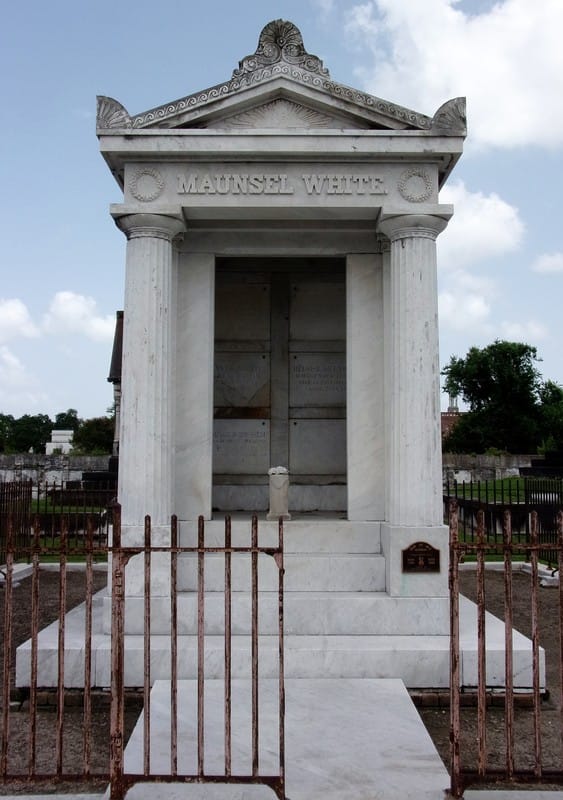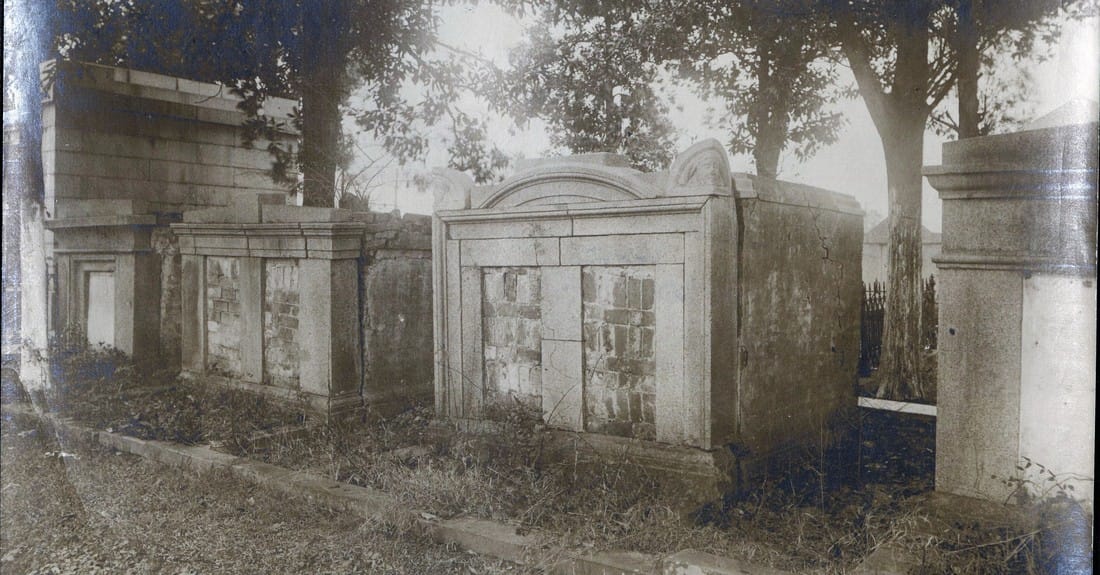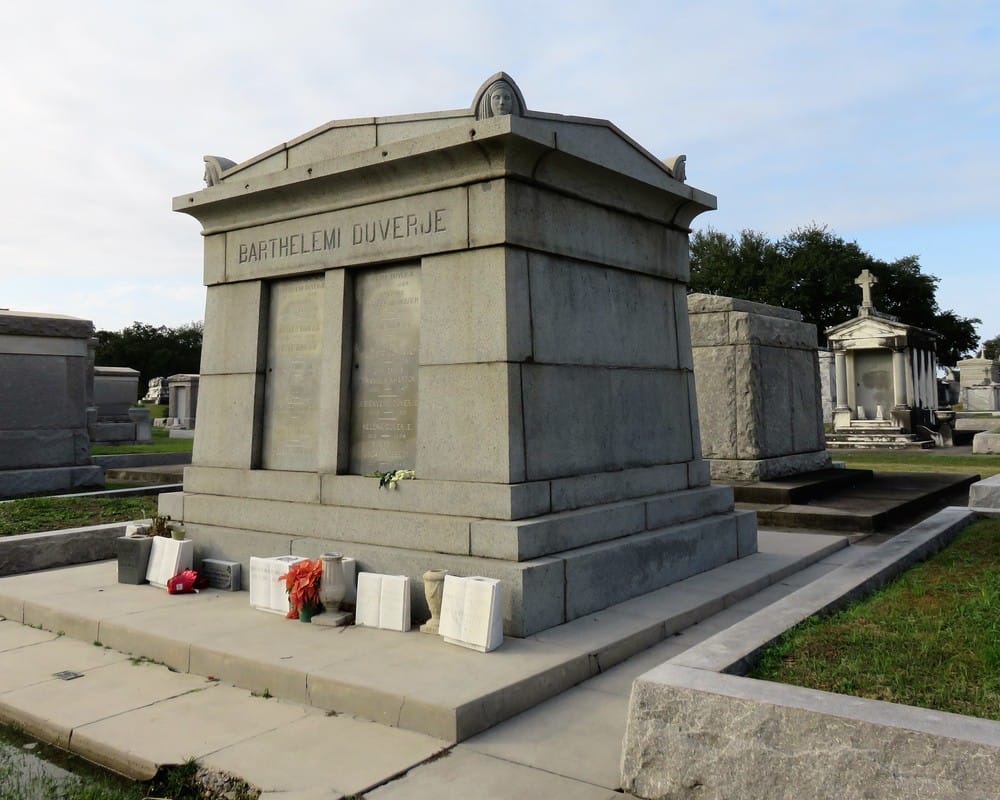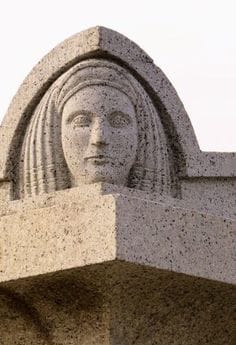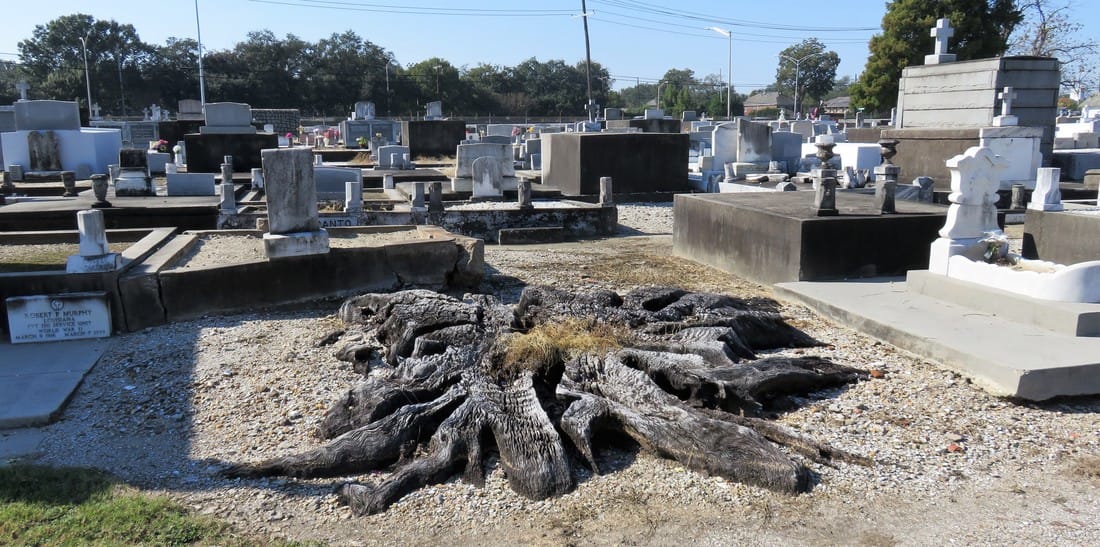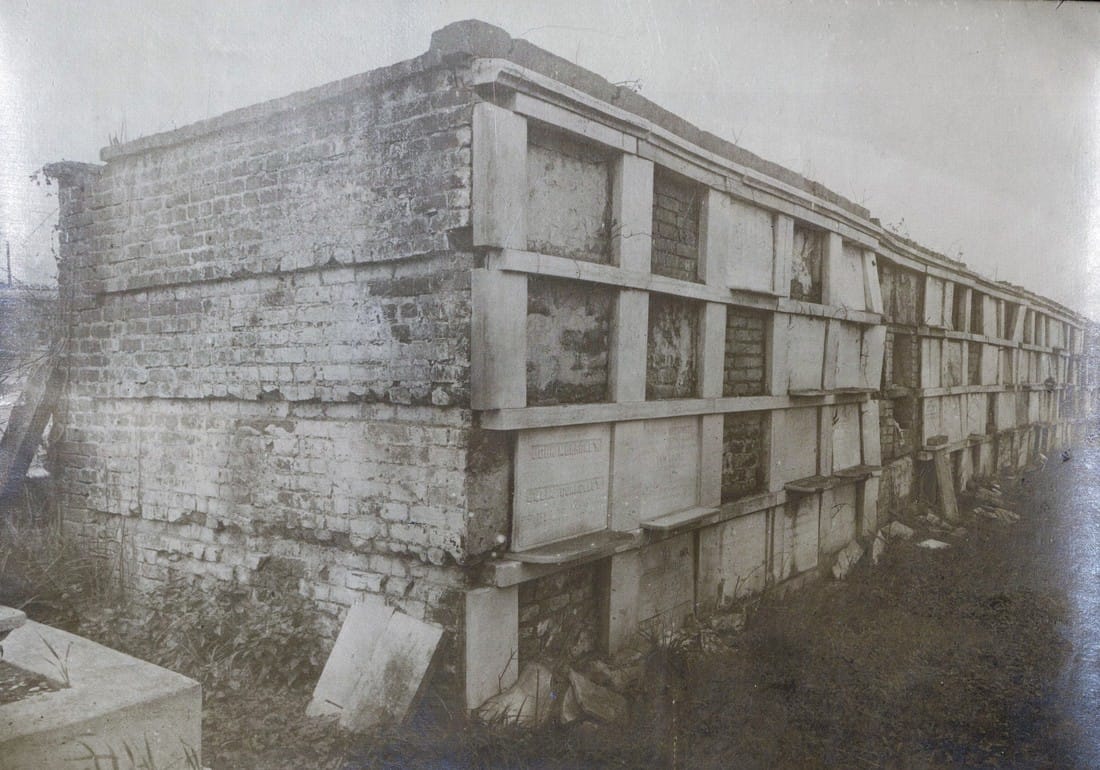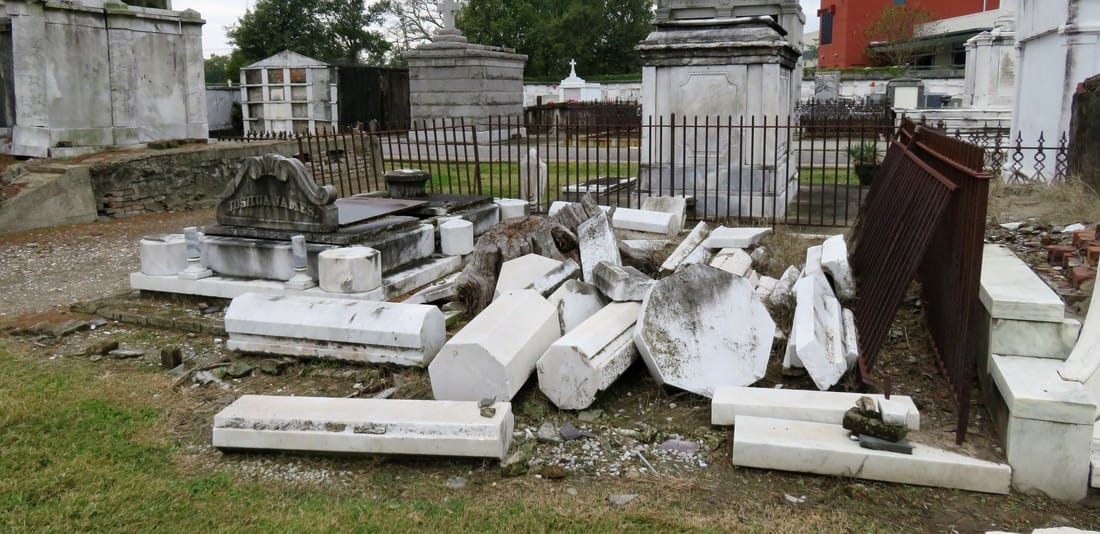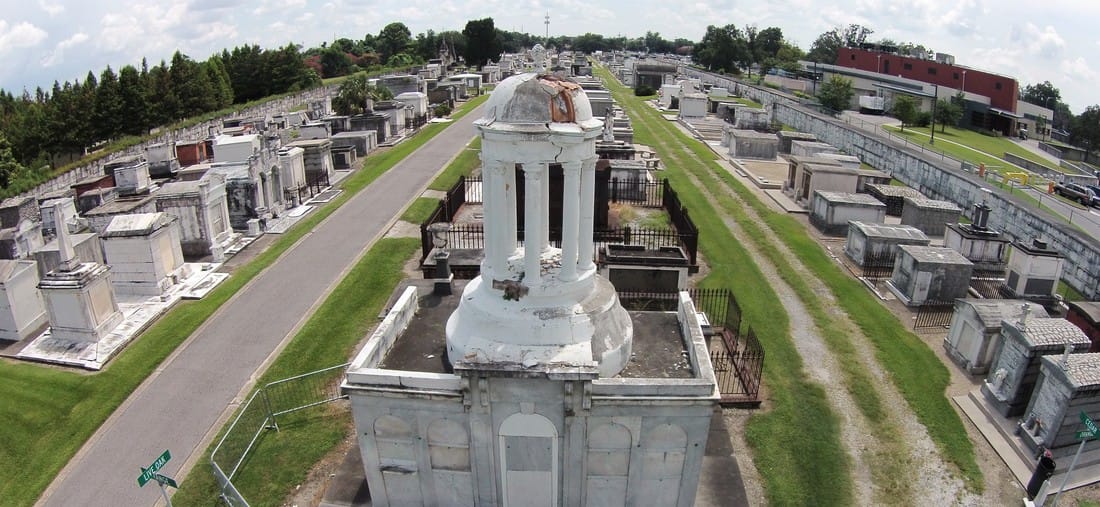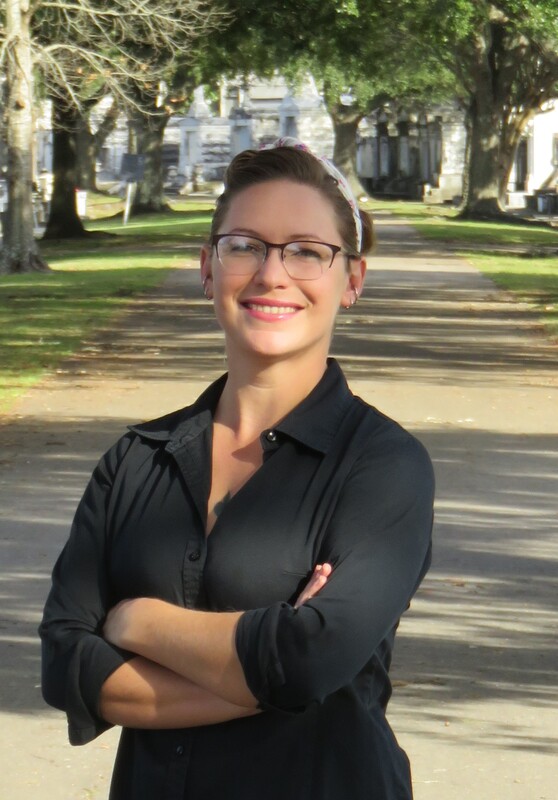|
Part Two of Two in an examination of historic architectural landscapes at Cypress Grove Cemetery. Find Part One here. In the 1840s, Cypress Grove Cemetery developed into the landscape its founders envisioned: tree-lined and populated with tombs of the finest order. It also gained company as St. Patrick’s Cemetery, Charity Hospital Cemetery, and Odd Fellows Rest were all established between 1840 and 1850. There at the corner at what is now Canal Street and City Park Avenue, Cypress Grove was part of a pastoral scene: barges floating up Bayou Metairie and the New Basin Canal, visitors strolling the gardens at the Halfway House, and rail cars pulling up right to the cemetery gates, unloading mourners and the bodies of the mourned.[1] Between its founding in 1840 and the turn of the century, Cypress Grove would become the final resting place of many famous and infamous New Orleans characters. Northern-born transplants to the city would combine New Orleans tomb architecture with the styles and materials they were accustomed to. Firemen would memorialize their fallen brethren within the cemetery’s marble-clad walls. Much of the incremental detail of the cemetery at its height, though, has weathered away from its present-day appearance. It’s easy to miss this historic garden cemetery for its modern lack of trees. But with historic research and a keen eye, it’s possible to rediscover Cypress Grove’s historic grandeur. Firemen, Northerners, and Protestants Cypress Grove was the first fraternal cemetery in New Orleans. All other cemeteries founded up to 1840 belonged either to the Catholic parishes (except Protestant Girod Cemetery, belonging to Christ Church Cathedral) or to each respective municipality (i.e. Lafayette Cemetery No. 1). Many other fraternal organizations, including other firemen’s organizations, would found their own cemeteries over the course of the nineteenth century. Cypress Grove was not intended for the exclusive burial of firemen. It served all New Orleanians seeking burial, if they could purchase a plot, and many who could not. Cypress Grove Cemetery No. 2 (present-day Canal Boulevard) was contracted by the City of New Orleans for indigent burial, even after Charity Hospital Cemetery was established in 1848.[2] While Catholics in New Orleans had many cemeteries from which to choose, Protestants had only Girod Street Cemetery and the municipal cemeteries. Perhaps it was simple economics that caused so many Northern-born Protestants to buy property in Cypress Grove. It may also have been caused by cultural interaction between the Firemen (many of whom were also non-native New Orleanians) and others who joined them as newcomers in the Crescent City. In any case, the great majority of historic burials in Cypress Grove denote birth in northern climes such as Pennsylvania, New York, Connecticut, and others. The Firemen’s Charitable Association fell into this market easily. Stonecutters whose work featured mostly in Girod Street Cemetery, such as long-time Girod Street sexton Horace Gateley, executed tombs and tablets in Cypress Grove as well. Gately himself, who drowned in at Isla del Padre, Texas in 1867, is buried in adjoining Greenwood Cemetery. The FCA even advertised in-ground burial in Cypress Grove. While in-ground burial occurred in nearly every cemetery in the city, FCA was the only cemetery owning body to advertise it – plainly appealing to newcomers with a distaste for Continental-inspired above-ground tombs.[3] When Girod Street Cemetery was demolished in 1957, Cypress Grove became a de facto artifact of what the Protestant cemetery may have looked like. Simpler, sarcophagus-style tombs with accents placed more on great obelisks and sculpture than on Greek acroteria or Baroque scrollwork dotted the aisles of both Girod and Cypress Grove. What few photos of Girod Street Cemetery remain even suggest a few duplicate tombs between both cemeteries: including the now headless and armless tomb statue and tomb of Henrietta Sidle Davidson (died 1881) and another tomb in Girod Street. Philadelphia brick, New Hampshire granite, and other Anglo-inspired tastes contributed to the budding landscape of Cypress Grove.
Mr. [S.T.] Jones placed a closely sealed bottle in the box, containing the constitution and list of members of this efflisient [sic] company, the daily newspapers of the city, and the various coins of the country. This was also embedded in mortar, the cover put on, and the whole covered with solid masonry, upon which the corner stone was laid. The beauty of the day, the solemnity of the occasion, and the mournful memories engendered by the scenes around, all contributed to give the ceremony a peculiar interest.[5] The tomb of Perseverance Lodge No. 13 dominated the entrance of Cypress Grove Cemetery then as it does now – a large terra cotta cupola with ionic columns and a cast-iron finial at its dome was constructed atop the tomb roof. At the center of its primary façade, an entrance was likely constructed which was enclosed by cast-iron doors. Above this door were marble brackets and a Classical pediment. The tombs of Philadelphia Fire Engine and Eagle Fire Company were tucked into the front corners of the cemetery. Each built identically, with marble-clad masonry and large urns and finials, they were each enclosed with iron gates, each within the line-of-sight of the Irad Ferry monument. Masterpieces in Marble and Granite Other societies in addition to fire companies would build their tombs in Cypress Grove, most notably the Chinese tomb and Baker’s Benevolent Association tomb. But Cypress Grove would make its mark in the number of great family tombs that populated its aisles. The sarcophagus tomb is one of the most notable artifacts of funerary architecture in New Orleans cemeteries, and in Cypress Grove this was no different. Built of brick and clad in marble pilasters, cornicework, and sculptural elements, the sarcophagus tombs of the McIlhenny, Davidson, Johnston and Walker tombs are examples of the dozens of this burial type found in Cypress Grove. Built by stonecutters like Anthony Barret, James Reynolds, and Newton Richards, they represented the English-speaking stonecutter’s take on a burial style often associated with Creole artisans. The French-speakers were present in Cypress Grove, as well. Sarcophagus tombs by signed by Florville Foy are present beside the work of New Orleans-born Jewish stonecutter Edwin I. Kursheedt. Renowned French-born cemetery architect J.N.B. de Pouilly designed two of the best-known tombs in Cypress Grove: those of Maunsel White and Irad Ferry (constructed by Monsseaux and Richards, respectively).
The only remaining example of this style of historic tomb construction lies not in Cypress Grove but in Metairie Cemetery – the Duverje family tomb, constructed between 1808 and 1820 and moved from the family cemetery in Algiers in 1916, retains such acroteria. They are the last of their kind in New Orleans cemeteries. Then and Now After 1945, New Orleans cemeteries underwent a seismic shift in management, industry, and trade. The monument industry had been slowly becoming a national affair managed by large companies – a shift that reached New Orleans after World War II. Over the years, most cemeteries abandoned the employ of the cemetery sexton who traditionally cared for the grounds on a daily basis. Stonecutters, who had often served as sextons, adapted and became cemetery owners and dealers of nationalized products. Technology changed the way tombs were built, repaired, and maintained. This shift affected every cemetery in New Orleans. In the Catholic cemeteries, it led to the consolidation of parish burial grounds into the incorporated New Orleans Archdiocesan Cemeteries. In municipal cemeteries, it meant a transfer of management to overstretched city departments that cared for publicly-owned buildings and parks.[7] In the fraternal cemeteries, it meant a consolidation of duties and a new focus on sellable space to accommodate budget shortfalls.[8] With population movement to the suburbs and elsewhere, tombs were less likely to be cared for by their owners. With no sexton to manage the landscape, small issues with tombs became larger problems, often solved in the quickest and cheapest way possible. Storms like Camille, Betsy, and Katrina flooded Cypress Grove Cemetery, killing many of the surviving trees. Those who entered the monument trade after 1950 were much more familiar with new technologies than old materials. Old problems, then, were solved in new ways. In the 1960s, when the marble facing of the extensive wall vaults at Cypress Grove began to sag away from their brick substrate, the decision was made to remove the marble instead of repair it. When landscaping tumuli was too labor intensive, the sod was stripped from their structures, leaving cement-patched, igloo-like bodies behind. Herbicides like RoundUp were selected to replace arduous mowing, damaging masonry and causing grassy root structures to erode, leaving deep ruts which can destabilize walls and tombs. Alternately, trees which lent such a rural feel to Cypress Grove eventually overgrew their root structures, tipping walls and capsizing tombs. All the while, the responsibility of families to care for and repair their own cemetery property became anachronistic in an era of new innovations and perpetual care. The cultural forces that created Cypress Grove had transformed, with the role of the fraternal society somewhat supplanted by the rise of Social Security and insurance companies; the rural cemetery now firmly at the edges of the metropolis. New Orleans cemeteries in general are prized for their historic value, but the value of their maintenance and preservation may exceed that interest from many sides. Yet Cypress Grove remains, its Egyptian columns rising above Canal Street and City Park, where once the bayou and the railroad met. It may be difficult to see it, but with a conscientious eye and a little history, its lost landscapes can be found. [1] “Passenger and Freight Barges on the New Canal,” Daily Picayune, January 1, 1846, 4; Leonard V. Huber, Peggy McDowell, Mary Louis Christovich, New Orleans Architecture, Vol. III: The Cemeteries (Gretna: Pelican Press, 2004), 30-35; At least one duel also took place in front of Cypress Grove’s gates, between former state senator Waggaman and a former New Orleans mayor Prieur, Daily Picayune, March 11, 1843, 2.
[2] Daily Picayune, April 21, 1846, 2. [3] “Cypress Grove Cemetery,” Daily Picayune, September 15, 1842, 2. Full text: “CYPRESS GROVE CEMETERY. A portion of this rural cemetery having been appropriated for interments in GRAVES, application can be made at the Firemen’s Insurance Office; to M.C. Quirk & Sons, or Mr. Monroe, Undertakers. The Superintendent will also receive at the ground any corpse for interment, on payment of $5 for grown persons and $3 for children. GEORGE BEDFORD, President F.C.A.” [4] “Grand Fancy Dress Ball,” Daily Picayune, February 26, 1852, 3; “Fireman’s Funeral,” Daily Picayune, August 14, 1847, 2. [5] “The City: An Interesting Ceremony,” Daily Picayune, January 3, 1854, 1. [6] Cohen’s New Orleans Directory for 1855 (New Orleans: Printed at the office of the Picayune, 66 Camp Street, 1855), xiv. [7] Pie Dufour, “Old Cemetery Getting New Look,” Times-Picayune, November 10, 1968. [8] In Cypress Grove, sexton and stonecutter Leonard Gately was instrumental in developing sections into sellable space. Daily Picayune, April 12, 1959, 154.
3 Comments
diane dempsey
12/21/2016 10:07:24 am
very very interesting
Reply
1/16/2022 11:11:40 pm
I Cannot Find My Grandmother's Burial Site, And Other Family Member's Buried There At Cypress Grove. ??? I Know The Grave Site Has Preputial Care, As It Was On My Grandmother's Paper's A Long, Long, Time Ago. That Gives Me Comfort To Know That My Mother , Uncle, Grandmother 's Site Is Not Being Destroyed .When I Put In My Mother's Name , Grandmother's Name And Uncle's Name To Find The Site, It Saud Their Was No Burial Site. I Know It Was There < I Was Visiting Just 3 Years Ago, So I Know It's There??? It Is Under The Name Of Elizabeth Castillion . I Would Like To Occ. Send Flower's. Is Their A Florist There? Thank You.
Reply
11/18/2023 10:08:08 am
All on 4 treatments, none at all ... What is the difference between All-on-4 Dental Implants and prostheses? All-On-Four Dental Implants are a permanent set of teeth that look and feel natural, unlike dentures https://turkeymedicals.com
Reply
Leave a Reply. |
About the Author:Emily Ford owns and operates Oak and Laurel Cemetery Preservation, LLC. Archives
November 2019
Categories
All
|
- About
-
Restoration
- Services
-
Portfolio
>
- Turning Angel Statue, Natchez, MS
- Ledger Monument, Baton Rouge, LA
- Pyramid Statuary, New Orleans, LA
- Bronze and Granite Monument, Carville, LA
- Box Tomb, New Orleans, LA
- Vernacular Concrete Monument, Pensacola, FL
- 1830s Family Tomb, Covington, LA
- 1850s Family Tomb, New Orleans, LA
- 1880s Family Tomb, New Orleans, LA
- Headstone and Monument Restorations, Pensacola, FL
- Society Tomb, New Orleans, LA
- Education
- Blog
- Contact
|
Oak and Laurel Cemetery Preservation, LLC is a preservation contractor in New Orleans, Louisiana, specializing in historic cemeteries, stone conservation, educational workshops and lectures. Oak and Laurel serves the region of the Southeastern US.
|
QUICK LINKS |
CONNECT |
Proudly powered by Weebly

